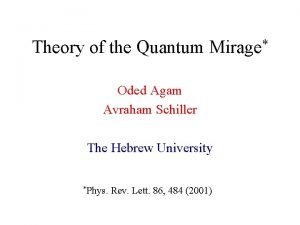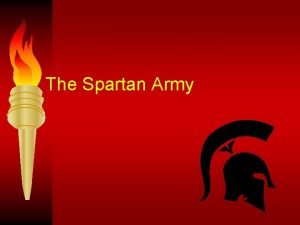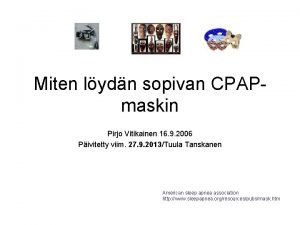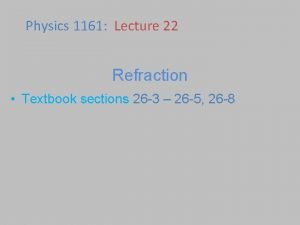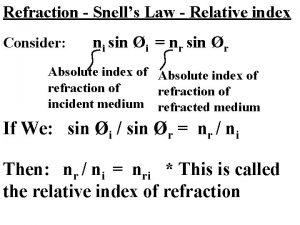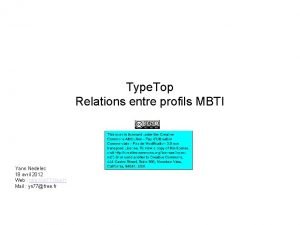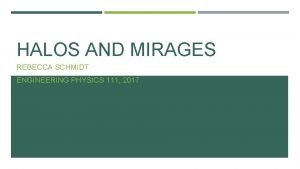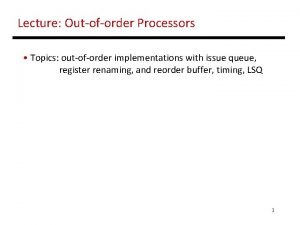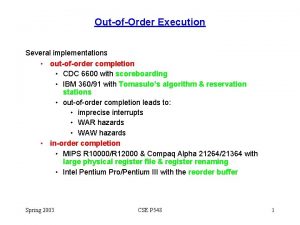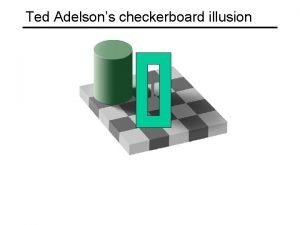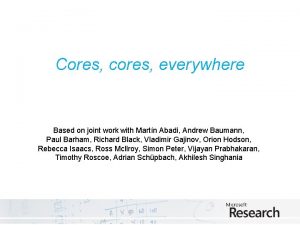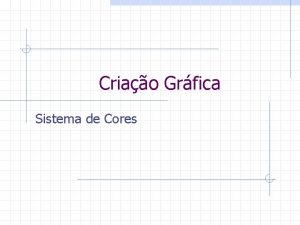Mirage Cores The Illusion of Many Outoforder Cores























- Slides: 23

Mirage Cores: The Illusion of Many Out-of-order Cores Using In -order Hardware Shruti Padmanabha, Andrew Lukefahr*, Reetuparna Das, Scott Mahlke Micro-50, Boston Oct 18, 2017 University of Michigan Electrical Engineering and Computer Science *Now at Indiana University

General purpose computer architectures System throughput Energy efficiency Single-thread performance 2

Heterogeneous CMP architectures Oo. O Out-of-order Core System throughput • Energy efficiency • • • CMP Area High performance Dynamically reorders instructions Large, complex, onesize fits all design Low energy efficiency Single-thread performance 3

Heterogeneous CMP architectures Oo. O In-Order Core • • • Chip Area Smaller, simplistic design Low area Low power Issues instructions in program order Low performance System throughput Energy efficiency Single-thread performance 4

Heterogeneous CMP architectures In. O In. O Oo. O Chip Area System throughput Energy efficiency Single-thread performance 5

Mirage Cores - Objective Single-thread performance System throughput More In. O cores More Oo. O-like In. O cores Energy efficiency 6

Background: Dyna. MOS “More Oo. O-like In. O cores” Program Traces Oo. O Sched $ In. O Memoize! Oin. O HW 70% of the traces have equivalent schedules for most of their lifetimes Oin. O vs In. O Performance: 1. 4 X Area: 1. 2 X Energy: 1. 4 X 7

Mirage Cores: Motivations Memoization opportunities vary based on program/phase characteristics In. O cores can utilize memoized traces for phases of millions of instructions Oin. O Oo. O Oin. O 8

Mirage Cores: Concept Oo. O+ Oo. O Schedule producer In. O+ Oin. O Oo. O In. O+ In. O Oin. O In. O+In. O System throughput Oin. O In. O+ Oo. OOin. O In. O+ Oin. O Chip Area Energy efficiency Single-thread performance 9

Mirage Cores: Challenges Oo. O+ Oo. O Schedule producer In. O+ Oin. O In. O+ Efficiently time-share the Oo. O • Architecture • # Oin. Os per Oo. O • Minimize overheads Oin. O • Effectively arbitrate between applications • Metrics? • Goals? 10

Mirage Cores: Architecture Oo. O L 1 i$ Sched$ In. O+ Oin. O L 1 d$ Sched$ Interconnect To Shared L 2 L 1 i$ Arbitrator L 1 i$ Sched$ In. O+ Oin. O L 1 d$ L 1 i$ Sched$ In. O+ Oin. O To Shared L 2 L 1 d$ L 1 i$ Sched$ In. O+ Oin. O L 1 d$ … 11

Arbitration Between Applications Oo. O Candidate Arbitrator App 0 Time 1 Million cycles App 1 Execution metrics ? ? App 0 App 2 App 3 … 12

Metrics for arbitration Execution metric Determines Measure Memoizability Single-application speedup ∆Sched$-MPKI 13

Memoizability - ∆Sched$-MPKI delta = IPC Relationship between performance and Sched$-MPKI for bzip 2 . . . Program in increasing order of 1 M cycle intervals 14

Metrics for arbitration Execution metric Determines Memoizability Single-application speedup Slowdown System throughput Time on Oo. O Fairness Measure ∆Sched$-MPKI 15

Goals for arbitration 1. Maximize energy efficiency 2. Maximize system throughput Oo. O Traditional Heterogeneous CMP 3. Guarantee fair/priority based resource allocation Oo. O 16

Evaluation Methodology Architectural Feature Parameters Oo. O Core 3 wide O 3 @ 2 GHz 12 stage pipeline 128 ROB Entries 128 entry PRF, 32 entry LSQ In. O Core 3 wide In. Order @ 2 GHz 8 stage pipeline 128 entry PRF, 32 entry LSQ Memory System 32 KB L 1 i/d cache, 2 cycle access 8 KB Schedule cache, 1 cycle access 1 MB L 2 cache, 15 cycle access 1 GB Main Mem, 100 cycle access Simulator Gem 5 Energy Model Mc. PAT 17

Evaluation Experimental parameters Parameters Number of cores n-In. O + 1 Oo. O Baseline n-Oo. O Workloads Random mixes of n-benchmarks from spec 2 k 6 Each run for a 1 billion instruction simpoint 18

Architectures for comparison 8: 1 configuration Traditional Heterogeneous CMP In. O Oo. O (booster) Mirage Core CMP OIn. O Oo. O + Sched Producer In. O OIn. O Homogeneous Oo. O CMP Oo. O Oo. O Homogeneous In. O CMP In. O In. O 19

App 7 App 5 Traditional Het-CMP Mirage (no memoization) Cores 100% 54% energy savings over homogeneous Oo. O CMP with 16% 100% Homo-Oo. O STP loss 80% OR Homo-In. O 60% 24% STP gains over homogeneous In. O CMP with 14% energy 60% overhead 40% 20% 0% App 1 App 2 App 6 Energy Rel to Homo. O Performance Rel to Homo-Oo. O 8 In. Os with 1 Oo. O App 0 App 4 App 3 Homo-Oo. O Homo-In. O 20% 0% 20

Size of cluster Traditional Het-CMP (no memoization) Perforamnce Relative to Homo-Oo. O Utilization of Oo. O 100% 90% 80% 70% 60% 50% 40% 30% 20% 10% 0% 4 8 12 16 Mirage Cores Homo-Oo. O 100% 90% 80% 70% Homo-In. O 60% 50% 40% 30% 20% 10% 0% 4 8 12 16 Number of Oin. O cores per Oo. O is oversubscribed for n >=12 21

Conclusion Reordered schedules System throughput Energy efficiency Single-thread performance In. O+ Oin. O In. O+ Oin. O Oo. O+ Oo. O Schedule producer Achieve > 80% of a homogeneous Oo. O CMP with > 20% area and > 50% energy savings 22

Mirage Cores: The Illusion of Many Out-of-order Cores Using In-order Hardware Questions? Shruti Padmanabha, Andrew Lukefahr, Reetuparna Das, Scott Mahlke Micro-50, Boston Oct 18, 2017 University of Michigan Electrical Engineering and Computer Science
 Refraction of light meaning
Refraction of light meaning Quantum mirage
Quantum mirage Katarzyna matoga
Katarzyna matoga Theysc
Theysc The good the bad
The good the bad Resmed finland oy
Resmed finland oy Mirage definition physics
Mirage definition physics Relative index of refraction
Relative index of refraction Mbti top
Mbti top Superior vs inferior mirage
Superior vs inferior mirage Diễn thế sinh thái là
Diễn thế sinh thái là Sự nuôi và dạy con của hổ
Sự nuôi và dạy con của hổ Ng-html
Ng-html V cc
V cc Phép trừ bù
Phép trừ bù Alleluia hat len nguoi oi
Alleluia hat len nguoi oi Lời thề hippocrates
Lời thề hippocrates đại từ thay thế
đại từ thay thế Thiếu nhi thế giới liên hoan
Thiếu nhi thế giới liên hoan Vẽ hình chiếu vuông góc của vật thể sau
Vẽ hình chiếu vuông góc của vật thể sau Quá trình desamine hóa có thể tạo ra
Quá trình desamine hóa có thể tạo ra Công thức tính độ biến thiên đông lượng
Công thức tính độ biến thiên đông lượng Dot
Dot Sơ đồ cơ thể người
Sơ đồ cơ thể người

